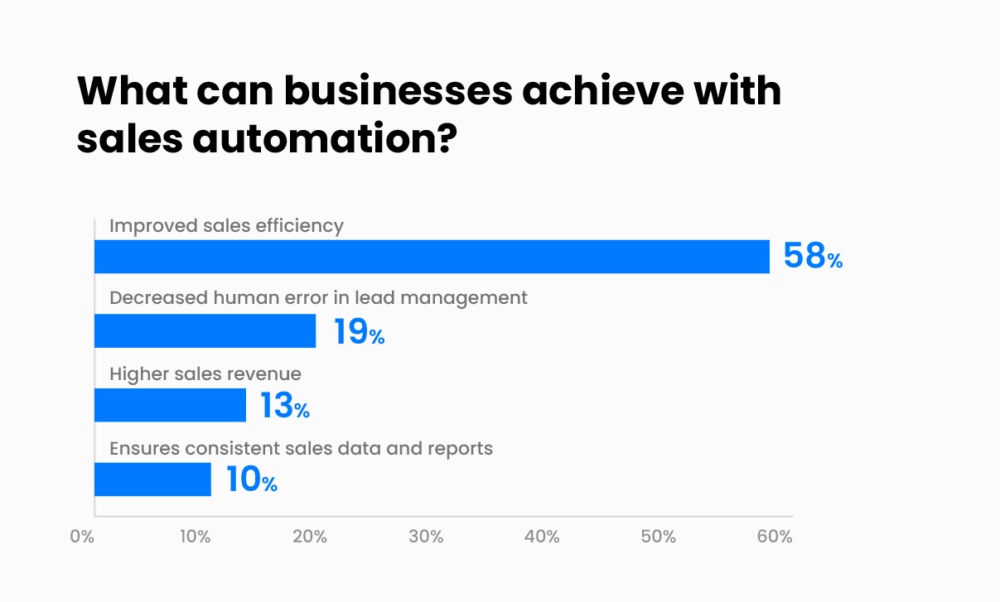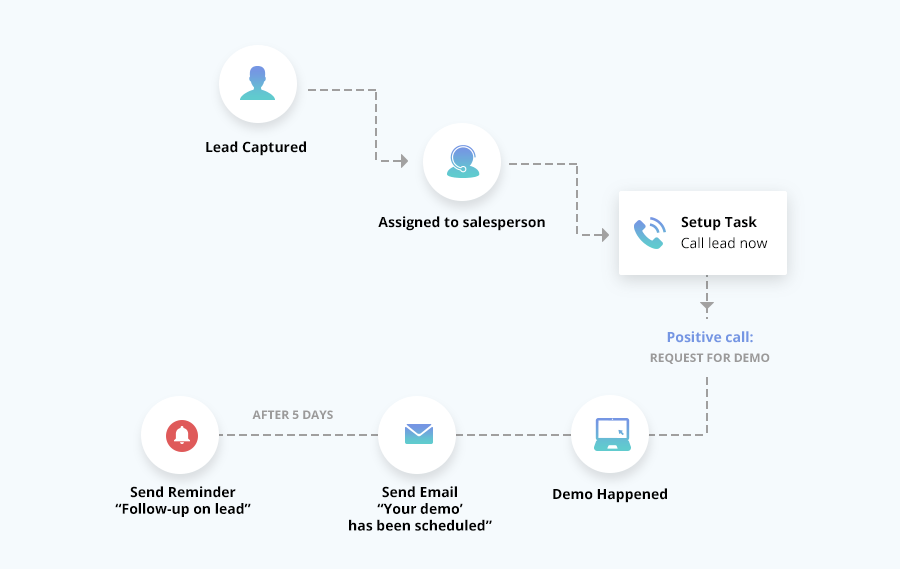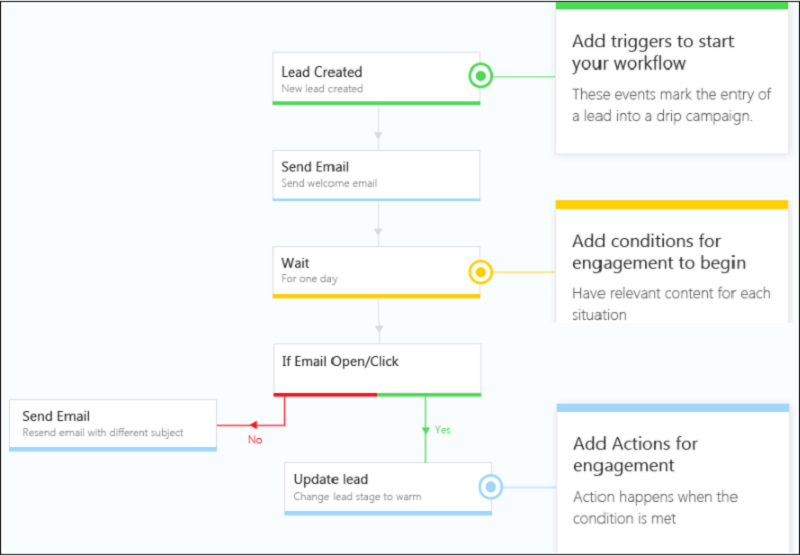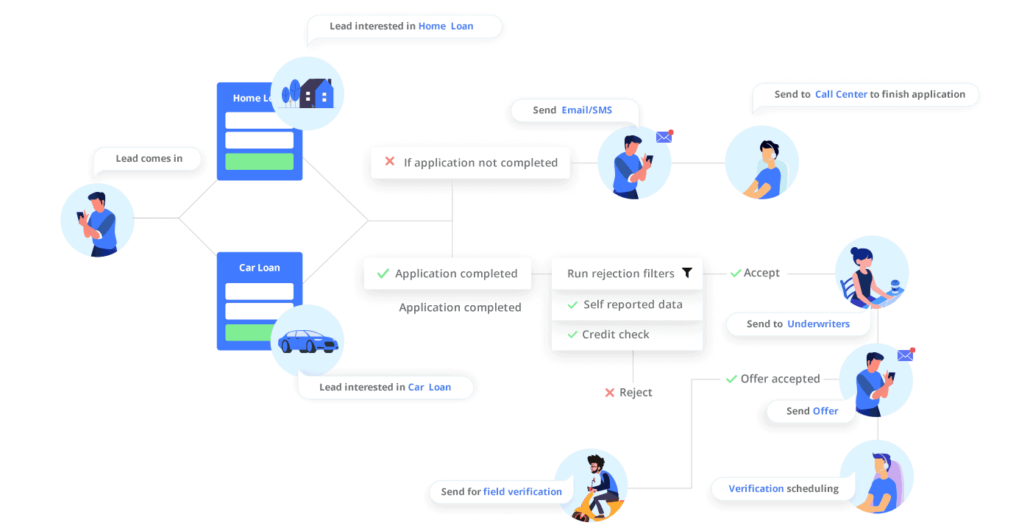From making a smoothie or doing your laundry to the SpaceX launch, automation is all around us. A simple button takes away hours of work and the need to plan. But, in contrast, your employees may still be entering mountains of data on to excel sheets. A never-ending and mind-numbing task, that distracts them from improving their performance at things that matter.
The good part is that you’ve landed on this article because Workflow Automation is just the solution you need. The even better part is that it’s not as complicated, time-consuming, or as expensive as you might think.
Let’s get right into what workflow automation is and how you can implement it for your business.
What is Workflow Automation?
Workflow automation is a way to automate manual tasks using a software and a set of well-defined set rules. Business workflows across various teams and industries can be easily automated to speed up operations, minimize errors, and increase productivity.
To simplify it further, automation saves the time that your team loses out on while entering data, generating reports, sending out emails, planning daily schedules, and even updating you on their progress.
There are many other benefits of workflow automation. If you’re on the fence about what automation can help your business achieve, take a quick look at a few of these advantages.
Benefits of Workflow Automation
Happier employees! Well, we can’t guarantee that but here are 7 ways in which workflow automation simplifies every employee’s workday.
- Improve customer relationships
- Enhances communication across teams
- Smarter and faster reporting
- On-time tasks with no human errors
- Manage multiple operations parallelly
- Forecast and plan for the future
- Higher team productivity
To achieve these benefits, businesses need to set the right workflows in place. There a couple of types of workflows and understanding all of them can be tough. So, let’s simplify it by looking at a couple of examples and the different types of workflow automation.
Types of Workflow Automation
Depending on the nature of your business and process needs, there are three types of workflow automation that you can choose from—sequential workflows, state machine workflows, and rules-driven workflows.
As the name suggests, a sequential workflow is a progressive flowchart. It follows a particular sequence of events, going from one task to another without any deviation in the pre-determined sequence.
A state-machine workflow is more complex in that it is an event-dependent workflow designed to follow pre-defined legal states on the workflow and the legal transitions between those states. It essentially means that it does not have to follow a particular sequence and can step back in the sequence if the state so demands.
In a rules-driven workflow, pre-defined rules and conditions guide the progress of activities. Expressions like “if,” “then,” “else,” or “wait,” are used as conditions to determine the next course of action in the workflow.
Automation can be triggered from various touchpoints and established to speed up tasks for all your departments. The true magic of workflow automation lies in creating customizable or completely tailored workflows for your business.
Implementing automation can be an expensive affair, but if you figure out which business challenges you aim to tackle first, it can deliver a high ROI. In the next segment, we’ll understand workflows specific to the different departments and their challenges.
Department-Specific Examples of Workflow Automation
1. Workflow Automation for Sales
Salespeople often run short of time and squeezing their tasks in a limited timeframe can increase errors in the data. In a LeadSquared survey, we found out that sales automation improved sales efficiency for 58% of businesses and decreased human errors for 19% of them.

Automated workflows in sales include:
- Lead distribution and routing
- Meeting, demo, and daily activity scheduling.
- Sales forecast and pipeline management.
- Streamline customer onboarding and document management.
- Order and inventory management to fulfil orders with ease.
- Automate approval processes to speed up discount approvals for larger teams.
- Internal communications for reminders, updates on sales performance, and tracking progress.

Resources to set up sales workflow automation:
- A Complete Guide to Sales Force Automation
- Webinar on Finding the Right Approach to Sales Automation in 2023 where Sandeep T. Mohan, Head of Inside Sales, Outplay shared his expertise.
2. Workflow Automation for Marketing
Marketing campaigns can get tough to plan and schedule, especially when you have thousands of potential customers in your database. Marketers need to be able to scale up their email and SMS campaigns while keeping them as personalized as possible. Knowing which leads to focus their marketing efforts on is another challenge that they face.
Marketing automation simplifies these challenges while enabling targetted and personalized communication in just a few clicks.
Automated workflows in marketing include:
- Reactivating old leads using email marketing campaigns.
- Nurturing leads towards conversions after they have interacted with your business.
- Onboarding new users or providing them a product walkthrough.
- Utilize purchase history to automate cross-selling and upselling.
- Ask for reviews once your user has tried the product or service over a certain period of time.
- Improve the effectiveness of marketing campaigns with A/B split tests.
Here are a few resources to set up workflow automation for your marketing team:
3. Workflow Automation for Finance Teams
Financial operations need to be accurate, error-free, and depend on many processes that impact the business’ bottom line. These operations include budgeting for different teams, maintaining book of business, approving expense invoices, and much more.
As the scale of historical data and the number of transactions increase, manual processes begin to get complicated. The chances of incurring human error shoot up as well.
Automated workflows for financial teams include:
- Automation for accounts payable by integrating vendor portals to a common platform.
- Faster approvals by routing invoices to the department heads for approval. Once approved, the invoice is automatically processes.
- Managing employee expense reports and approvals.
- Forecasting and planning financial budgets based on expenses and historical data.
- Workflows for internal audits based on data collection, financial statements, and other documents.
- Ensuring proper compliance and regulations for financial data.
4. Workflow Automation for Human Resources
HR Workflows are generally repetitive and predictable, which makes them easy to automate. With multiple employee lifecycles running in parallel, automation makes all the processes manageable. Privacy and secure transfer of data is one of the most important aspects of automated workflows for the human resources team.
Automated workflows in human resources include:
- Track leads based on referral sources and assign interviews with department heads.
- Manage applications and recruitment leads.
- Collect and store applicant information.
- Automated interview scheduling and email reminders to ensure that the interview takes place on time.
- Auto check in/check out for attendance management.
- Managing monthly payroll and benefits for employees.
- Conduct performance reviews by setting up review meetings and automating feedback collection.
- Understand 360-degree user profiles with activity tracking to create targeted campaigns.
5. Workflow Automation for Customer Service
Delayed responses, especially when your user is looking for a quick fix, quickly drive your users away. While automation can’t completely replace human interactions, they can be a buffer until your customer service reps are available to get in touch with the user. For example, an automation can at least notify the user of when the service rep will be available. It’s important to note that customer service also extends towards customer retention and decreasing churn.
India’s largest network of audiology providers—Hearing Solutions—replaced their forms and human customer service methods using Chatbots. They saw a 50% increase in their conversion rate when they added the Chatbots to their website.
Arnav Patel, Marketing Lead, TARS
Workflow automation for customer service include:
- Collecting leads via chatbots for product demonstrations, or to resolve frequently asked questions.
- Enable a system to raise tickets and assign enquiries to the team based on availability.
- Collecting feedback and scheduling weekly/monthly review meetings with the customer.
- Sending automated emails to update the user about the status of the ticket raised by them.
- Ability to prioritize enquiries based on how importance or urgency.
- Maintaining a certain standard of personalized communication for all the customers.
Watch this recording from our webinar to learn how chatbots and customer service automation on a CRM can help you gain more customers.
The above-mentioned departments operate in a similar manner across companies but as we get into the specifics of every industry, the workflows tend to be unique and a tad bit complicated. There are a few important industry specific workflow use cases that can be implemented to improve customer experience. Let’s take a look!
Industry-Specific Examples of Workflow Automation
1. Workflow Automation for Healthcare
Healthcare industries focus on improving patient experience and creating a seamless patient journey. But understaffed facilities and overburdened teams need automated workflows to deliver quality care. Data privacy is the most important aspect to consider while creating healthcare workflows, so businesses should choose a workflow automation tool/software that is HIPAA compliant.
Examples of Workflow Automation in Healthcare:
1. Online and offline appointment scheduling process.
2. Integrate EHR systems with healthcare workflows and your Healthcare CRM to collate lab results, treatment procedures, and patient history on a dynamic database.
3. Streamline patient and doctor onboarding.
4. Track patient activity and prior treatments to personalize treatment.
5. Manage the activity and daily roster of your healthcare staff.
Check out these free resources to learn more about healthcare workflow automation:
2. Workflow Automation for Education Institutions
Higher Education institutes can increase their conversions by 50% by just improving their response time, which can be easily automated. The challenges that higher education workflow automation solves include high student drop offs and low enquiry to admission conversions.
Examples of Workflow Automation in Education:
1. Assign student leads to counsellors.
2. Schedule nurturing touch points via call and email interactions.
3. Share entrance test links and updates on the admission process.
4. Extend offer and acceptance letters.
5. Share updates and promotional content through email and SMS campaigns.

Free resources to learn more about workflow automation in higher education:
- 16 Education Workflow Automations for Your Admissions Teams
- Watch our webinar hosted by David Eby, VP of Marketing, New England College and Jason Pfaff, VP, Red Ventures to learn the best practices in Higher Education automation.
3. Workflow Automation for Financial Services
Businesses in the financial services sector have multiple teams working with a customer. These increase the chances of encountering errors or miscommunication. But implementing workflow automation in financial services improves efficiency, improves response rates, and ultimately boosts revenues.
A combination of clearly defined processes and LeadSquared’s automation has made our operations completely error-free. Automated lead assignment also helps us save a lot of time and bandwidth, and we can focus on what we do best—provide good insurance advice and service.
Lokesh Gurram, Co-founder, Ditto Insurance

Examples of Workflow Automation in Financial Services:
- Automated underwritings and approval processes to speed up conversions.
- Adopting IVR solutions and voice-based responses to decrease customer waiting times.
- Leaders can manage multiple reps with call center management to ensure that the quality and quantity of calls is being maintained.
- Improve operational efficiency, prioritize leads, and conduct virtual meetings with field sales management.
- Automate claims processing to improve the user’s experience.
Free resources to learn more about workflow automations in the financial services sector:
- Insurance Workflow Automation to Increase Sales
- An Introduction to Automation in Financial Services
- Watch our webinar for tips to run financial services on autopilot. Our guest speaker, Rob Joseph, Founder, Coinguide & MySMSF shared his learnings from the past and the trends that will guide the financial sector in the future.
4. Workflow Automation for the IT Industry
Workflow automation in the IT industry focuses on improving operational tasks along with the performance of sales teams. It can also be used to improve communication and collaboration within an organization by providing a central repository for documents such as decks, templates, and process information.
Examples of Workflow Automation in the IT industry:
- Provisioning of cloud infrastructure to host applications and services.
- Automated testing and deployment of code to ensure that new features and updates are released quickly and reliably.
- Streamline the incident response to outages with automated reports and assigning tickets/tasks to team members.
- Automating the stages in fulfilling IT service requests, such as provisioning new hardware or software installation.
5. Workflow Automation for Travel and Hospitality
Expenditure is a driving factor in the travel and hospitality industry. Just generating leads from OTA platforms takes up a chunk of profits from travel and hospitality businesses. Quality guest experience is another aspect that they can’t skimp on. Cancelled bookings and poor guest management are usually the culprits that can tank reviews and profits. Workflow automation is the solution to all these challenges.
Examples of Workflow Automation in the Travel and Hospitality industry:
- Complete room booking from offline and online sources, including lead capture and lead assignment. The complete workflow includes confirmations and payment processing.
- Customer service workflows to improve guest interactions and decrease response time.
- Inventory management to track room bookings and ordering supplies to ensure that they are always in stock.
- Nurturing customers by collecting post-stay feedback and sharing information about discounts and upcoming offers.
- Scheduling daily tasks and activities based on availability and skill sets.
Now that you have an idea about automated workflows and the kind of tasks they help you with, we’ll look at how you can set this automation up. The two most important aspects of it are creating the workflow and choosing a tool that can execute it with ease.
How to Create a Workflow Automation?
Follow these steps to create various kinds of workflow automations for your business.
Step 1: Identify the tasks and processes that can be automated
The first step is to identify tasks that are typically repetitive tasks that do not require much human intervention. Examples include data entry, email responses, social media posts, and document management.
Step 2: Determine the workflow automation tools and software
Once you have identified the tasks and processes that can be automated, the next step is to find the right tool or software you need to automate them. There are a wide variety of workflow automation tools available, ranging from simple automation tools to more complex workflow management systems. Some popular options include LeadSquared CRM, Zapier, IFTTT, Kissflow, and Microsoft Power Automate.
Step 3: Set up the automation
Setting up the automation usually involves creating triggers and actions that will initiate the automation process. For example, you may create a trigger that sends a notification to a team member when a customer makes a purchase, and an action that automatically sends a thank you email to the customer.
Step 4: Test and optimize
After setting up the automation, it is important to test the process to ensure that it is working as intended. This may involve running a few test cases with mock leads to see how the automation behaves in different scenarios. Once you are satisfied with the results, you can then optimize the automation by fine-tuning the triggers and actions to improve efficiency before it goes live.
Step 5: Monitor and maintain
After the automation is set up and running smoothly, it is important to monitor the process to ensure that it is still working as intended. This may involve regularly checking for errors or issues and making any necessary adjustments. It is also a good idea to review the automation periodically to see if there are any opportunities for further optimization.
And voila, you have your automation in place. Just kidding, the process will only be as simple as following these steps IF you choose the right software for it. Here’s a checklist that covers all the features that your workflow automation software must cover.
Checklist to Choose a Workflow Automation Tool
1. No-code platforms: Automation is supposed to simplify tasks, not complicate them. The tool that you choose should be a no-code platform that doesn’t require any technical expertise to adopt.
2. Visual Designers for Workflows: The automated workflow should be easy to design, build, and edit. Drag and drop builders with menus and tools provide a simple user interface.
3. Ability to Integrate: Automation spans across your entire business process so the tool that you choose should integrate and gather data from all your lead and process related sources. A tool that is compatible with different platforms with simple APIs.
4. Scalable: Workflow automation is a long-term and high-return investment that should scale up along with your business. The scale should be supported in terms of number of employees and processes set in place.
5. Project Management Capabilities: Reminders, notifications, and updates need to be shared to the leaders and employees in real time. The software should not just automate the process but also allow managers to monitor it on a daily basis.
6. Secure Platform: As your user data or company’s data flows through workflows, the platform should be secure and compliant with data-privacy laws. Businesses cannot rely on a software that is not secure as any data lost or leaked may land in your competitor’s hands. Look for a platform with a cloud-storage feature as they generally ensure higher data security.
7. Easy to edit workflows: You might want to edit your workflows based on how they perform. Frequent edits and customizations ensure that the automations improve over time, and you shouldn’t have to rely on support from the software to change the workflows.
Along with these points, you also need to look into the cost and customer service so that it aligns with your expectations. Workflow automation tools can be a standalone software or a part of a CRM. Both the options deliver the expected results, but a CRM is just more convenient since you get all the details and updates on a single, integrated platform.
LeadSquared CRM has helped over 2000 businesses, across various industries, automate their workflows for streamlined business operations and higher sales outcomes. LeadSquared’s capabilities and workflow automation help businesses manage routine sales tasks as lead distribution, opportunity nurturing, and sales approvals.
If you’re looking for effective solutions to decrease manual work and automate business workflows, you should give LeadSquared a shot! Get in touch with our team to get started on your automation journey.
FAQs
While automation offers pre-built templates, customization is crucial. Look for platforms that allow you to design workflows that align seamlessly with your unique sales process and team needs. This ensures automation complements, not replaces, your existing sales strategies.
Choose automation tools with built-in data validation features or integrations with your CRM system to minimize errors. Additionally, establish clear data entry protocols for your sales team to ensure data quality from the source. Regular data audits can also help identify and address any inconsistencies that might arise.
Automation shouldn’t replace human interaction entirely. Focus on automating repetitive tasks while reserving personalized communication and relationship building for your sales team. This ensures a balance between efficiency and the importance of human connection in the sales process.










